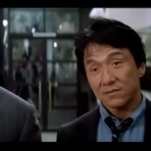Since yesterday’s post, I’ve seen my two favorite films in this year’s Competition lineup, and I think I can state with confidence that neither one has a chance in hell of winning the Palme d’Or. Which is fine, really. My taste is my own, and these are unquestionably minor works, likely to have very little lasting impact. They don’t necessarily merit a big-deal award. But that doesn’t mean they aren’t a hell of a lot of fun.
Judging from my Twitter feed, most folks here seem to agree that Drive is a winner. I expect a far more divisive response to This Must Be the Place, the first English-language effort by Italy’s Paolo Sorrentino—and frankly, I’m not entirely sure how to articulate why I enjoyed it so much. Certainly a plot summary won’t help: Sean Penn, of all people, plays an androgynous former rock star named Cheyenne who travels the U.S., in full makeup, searching for the fugitive Nazi who tormented his father at Auschwitz. But the glory of this movie is that it isn’t really about its crazy plot, or even its ludicrous protagonist (in whom Penn, alternately restrained and manic, locates a lovely undercurrent of melancholy). “We’ll get to that,” a random character played by Harry Dean Stanton tells Cheyenne twice in about 30 seconds, regarding two completely different subjects, and the phrase amounts to a credo of sorts; it’s a film about digression as epiphany, shot in a style that makes it seem as if Sorrentino is reinventing the world every few minutes. There’s something radically optimistic about the way that This Must Be the Place, in keeping with its title (yes, derived from the Talking Heads song; David Byrne appears and performs as himself), stubbornly refuses to close itself off to anything, so that each newly introduced character or situation—in many cases, each individual shot—seems to be the reason the movie was made. And yet at the same time everything seems ephemeral, gone in an instant, and that too feels strangely optimistic. I’m a little troubled by the ending, which struck me on a first viewing as both overly tidy and slightly reactionary, but for the most part this goofy rebuke to the road movie kept me grinning. Grade: B (leaning toward B+).
If This Must Be the Place is a movie that doesn’t especially care about its ludicrous plot, Pedro Almodóvar’s new film, The Skin I Live In, cares about nothing but its ludicrous plot. Which presents a bit of a challenge for anyone reviewing it, as it would be cruel to reveal too much about what happens, yet there’s nothing much else to talk about — except perhaps to note that the film’s subject matter reflects the lifelong preoccupations of a gay film director obsessed with women. Antonio Banderas, working with Almodóvar for the first time since 1990’s Tie Me Up! Tie Me Down!, plays a brilliant but deranged surgeon who maintains an operating room on his private estate and performs regular procedures on a beautiful young woman (Elena Anaya). All we know at the outset is that Banderas has created an unusually strong artificial skin, driven to the task after his wife died in a fire, and that the young woman seems to be held captive in his house, with the complicity of his housekeeper (Marisa Paredes). And that’s really all I ought to tell you, because the only real charge this movie offers is the gradual and increasingly fucked-up reveal of what’s actually going on. (If you have a guess based on the above description, trust me: Nope.) There’s no emotional subtext to the outré scenario, no sense that this lunacy reflects feelings too strong to be contained by an ordinary narrative; at the precise instant that the film threatens to address something real, it promptly ends. If you took a Weekly World News cover story and tried to reverse-engineer a screenplay from the headline, it might look something like The Skin I Live In. I wanted more. Grade: C+
Finally, I must apologize regarding Hong Sang-soo’s The Day He Arrives, one of my most anticipated films. At the risk of joining Lars von Trier as persona non grata, I confess that I, as a white dude, sometimes have trouble distinguishing faces in Asian movies—especially Hong’s movies, for some reason. (A pop-psych theory I’ve read: This is not really racism per se, but just an example of the brain economizing. If you see relatively few Asians in your daily life, then there’s no need—from the perspective of neurological processing power—for you to properly “learn” the nuances of their faces, since the brain can just file each one away under “Asian,” using the most obvious signifiers—epicanthic fold, etc. And so you don’t. Dunno if it’s true, but it makes me feel better.) So when an actress reappeared in Hong’s new movie, in which I gather may or may not be a different role, the intended ambiguity sailed right over my head—along with the movie’s central conceit, judging from reviews. I just plain didn’t recognize her, thought it was a different person entirely. Consequently, I just don’t feel like I can evaluate this movie with any confidence. It’s very Hong, I can tell you that. And shot in black-and-white. Sorry, folks.
Next time: Check back on Sunday for a wrap-up post following tomorrow’s awards announcement, plus quick reviews of the last few films to be screened, including Nuri Bilge Ceylan’s epic-sounding Once Upon a Time in Anatolia.








































